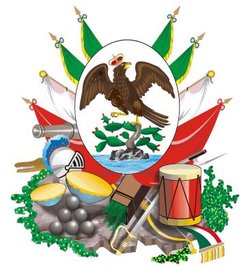Mexican Empire
|
|
The Mexican Empire was the name of Mexico on two non-consecutive occasions in the 19th century when it was ruled by an Emperor. (For the Pre-Columbian empires of Mesoamerica in the territory of modern-day Mexico, see Aztec, Toltec, and Teotihuacan.)
First Mexican Empire
The First Mexican Empire was short lived, lasting only eight months from 21 July 1822 to 19 March 1823 and having only one emperor, Agustín de Iturbide.
When the Emperor Napoleon of France put his brother, Joseph, on the Spanish throne in 1808, ties between Spain and her American colonies weakened and the movement for Mexican independence grew stronger.
The Mexican War of Independence began in 1810 and continued until 1821, when rebel troops entered Mexico City and the Treaty of Córdoba was signed, whereby Spain recognized Mexico's independence.
In that year, General Agustín de Iturbide, a Mexican-born criollo who originally fought for the pro-Spanish royalists but swapped his allegiance to the insurgents in the final phases of the war, was elected head of the provisional junta government and of the regency that held the imperial power that Spain once had. On the night of the 18 May 1822, a mass demonstration led by the Regiment of Celaya, who Iturbide had commanded during the war, marched through the streets and demanded that their commander-in-chief accept the throne. On 19 May 1822, the Sovereign Congress named him the emperor and on 21 May 1822, issued a decree officially confirming this appointment, which was officially a temporary measure until a European monarch could be found to rule Mexico.
Iturbide's official title was By Divine Providence (the Grace of God) and the National Congress, First Constitutional Emperor of Mexico (Spanish:Por la Divina Providencia y por el Congreso de la Nación, Primer Emperador Constitucional de México). His coronation took place on 21 July 1822, in Mexico City.
As factions in the Congress began to sharply criticise both Iturbide and his policies, the emperor decided on 31 October to dissolve it. This enraged the commander of the garrison at Veracruz, Antonio López de Santa Anna, who himself would be President in several terms, during the Secession of Texas and the disastrous Mexican-American War. Santa Anna and his troops rose up against Iturbide and declared a republic on the 1 December.
Fearing for his life as the rebellion grew stronger, the emperor ordered the dissolved Congress to reassemble on the 4 March 1823. He presented his abdication to them at a night-time session on 19 March 1823. He fled to Italy shortly after.
In April 1824 the Congress, having already declared his administration void, declared Iturbide a traitor. When he returned to Mexico in July 1824 he was arrested on arrival in Tamaulipas and executed.
Second Mexican Empire
Mexempire2.JPG
The Second Mexican Empire survived for longer than the First Empire, lasting for three years from 1864 to 1867. However, it still only ever had one emperor, Maximilian von Habsburg, who was installed by Napoleon III of France.
Emperor Maximilian was an unpopular leader and since he was a foreigner many countries and citizens did not regard him as a legitimate leader of Mexico. He was executed by firing squad in 1867.
External links
Imperial House of Mexico (http://www.casaimperial.org/)ca:Imperi Mexicà es:Imperio Mexicano ja:メキシコ帝国

